Comprehensive Evaluation of Spatial Distribution and Temporal Trend of NO2, SO2 and AOD Using Satellite Observations over South and East Asia from 2011 to 2021
Abstract
:1. Introduction
2. Methods
2.1. Air Pollutants and Emission Data
2.2 Study Region
2.3 Temporal Evaluation of Air Pollutants
2.4 Hotspot Identification (Spatial Evaluation)
3. Results
3.1 Spatial Distribution of NO2, SO2, and AOD
3.2 Regional Trend Analysis of NO2, SO2, and AOD
3.3 Seasonal Trend of Overall NO2, SO2, and AOD
3.4 Hotspots Identification
3.5 Emission Analysis of NOx, SO2, and PM2.5
4. Discussion
5. Conclusions
Supplementary Materials
Author Contributions
Funding
Data Availability Statement
Acknowledgments
Conflicts of Interest
References
- Lu, Z.; Zhang, Q.; Streets, D.G. Sulfur Dioxide and Primary Carbonaceous Aerosol Emissions in China and India, 1996–2010. Atmos. Chem. Phys. 2011, 11, 9839–9864. [Google Scholar] [CrossRef]
- Mulholland, E.; Miller, J.; Bernard, Y.; Lee, K.; Rodríguez, F. The Role of NO x Emission Reductions in Euro 7/VII Vehicle Emission Standards to Reduce Adverse Health Impacts in the EU27 through 2050. Transp. Eng. 2022, 9, 100133. [Google Scholar] [CrossRef]
- Kampa, M.; Castanas, E. Human Health Effects of Air Pollution. Environ. Pollut. 2008, 151, 362–367. [Google Scholar] [CrossRef] [PubMed]
- Kang, H.; Zhu, B.; van der, A.R.J.; Zhu, C.; de Leeuw, G.; Hou, X.; Gao, J. Natural and Anthropogenic Contributions to Long-Term Variations of SO2, NO2, CO, and AOD over East China. Atmos. Res. 2019, 215, 284–293. [Google Scholar] [CrossRef]
- Acharya, P.; Barik, G.; Gayen, B.K.; Bar, S.; Maiti, A.; Sarkar, A.; Ghosh, S.; De, S.K.; Sreekesh, S. Revisiting the Levels of Aerosol Optical Depth in South-Southeast Asia, Europe and USA amid the COVID-19 Pandemic Using Satellite Observations. Environ. Res. 2021, 193, 110514. [Google Scholar] [CrossRef]
- Mohammadi, M.; Neshat, E. Accurate Prediction of NOx Emissions from Diesel Engines Considering In-Cylinder Ion Current. Environ. Pollut. 2020, 266, 115347. [Google Scholar] [CrossRef]
- Olivier, J.G.J.; Bouwman, A.F.; Van Der Hoek, K.W.; Berdowski, J.J.M. Global Air Emission Inventories for Anthropogenic Sources of NO(x), NH3 and N2O in 1990. Environ. Pollut. 1998, 102, 135–148. [Google Scholar] [CrossRef]
- Eckel, S.P.; Cockburn, M.; Shu, Y.H.; Deng, H.; Lurmann, F.W.; Liu, L.; Gilliland, F.D. Air Pollution Affects Lung Cancer Survival. Thorax 2016, 71, 891–898. [Google Scholar] [CrossRef]
- EPA Final Integrated Science Assessment for Oxides of Nitrogen, Oxides of Sulfur, and Particulate Matter—Current Review of the Air Quality Criteria for the Particulate Matter NAAQS. EPA. Fed. Regist. 2020, 85, 66327–66328.
- He, X.; Pang, S.; Ma, J.; Zhang, Y. Influence of Relative Humidity on Heterogeneous Reactions of O3 and O3/SO2 with Soot Particles: Potential for Environmental and Health Effects. Atmos. Environ. 2017, 165, 198–206. [Google Scholar] [CrossRef]
- Li, R.; Cui, L.; Meng, Y.; Zhao, Y.; Fu, H. Satellite-Based Prediction of Daily SO2 Exposure across China Using a High-Quality Random Forest-Spatiotemporal Kriging (RF-STK) Model for Health Risk Assessment. Atmos. Environ. 2019, 208, 10–19. [Google Scholar] [CrossRef]
- Rupakheti, D.; Rupakheti, M.; Rai, M.; Yu, X.; Yin, X.; sKang, S.; Orozaliev, M.D.; Sinyakov, V.P.; Abdullaev, S.F.; Sulaymon, I.D.; et al. Characterization of Columnar Aerosol over a Background Site in Central Asia. Environ. Pollut. 2023, 316, 120501. [Google Scholar] [CrossRef] [PubMed]
- Ramachandran, S.; Rupakheti, M. Trends in Physical, Optical and Chemical Columnar Aerosol Characteristics and Radiative Effects over South and East Asia: Satellite and Ground-Based Observations. Gondwana Res. 2022, 105, 366–387. [Google Scholar] [CrossRef]
- Khamraev, K.; Cheriyan, D.; Choi, J. A Review on Health Risk Assessment of PM in the Construction Industry—Current Situation and Future Directions. Sci. Total Environ. 2021, 758, 143716. [Google Scholar] [CrossRef]
- Pateraki, S.; Manousakas, M.; Bairachtari, K.; Kantarelou, V.; Eleftheriadis, K.; Vasilakos, C.; Assimakopoulos, V.D.; Maggos, T. The Traffic Signature on the Vertical PM Profile: Environmental and Health Risks within an Urban Roadside Environment. Sci. Total Environ. 2019, 646, 448–459. [Google Scholar] [CrossRef]
- Faria, T.; Martins, V.; Canha, N.; Diapouli, E.; Manousakas, M.; Fetfatzis, P.; Gini, M.I.; Almeida, S.M. Assessment of Children’s Exposure to Carbonaceous Matter and to PM Major and Trace Elements. Sci. Total Environ. 2022, 807, 151021. [Google Scholar] [CrossRef]
- Rahman, M.M.; Shuo, W.; Zhao, W.; Xu, X.; Zhang, W.; Arshad, A. Investigating the Relationship between Air Pollutants and Meteorological Parameters Using Satellite Data over Bangladesh. Remote Sens. 2022, 14, 2757. [Google Scholar] [CrossRef]
- NASA Aura | OMI. Images, Data, Inf. Atmos. Ozone 2020. Available online: https://aura.gsfc.nasa.gov/omi.html (accessed on 20 May 2022).
- Levelt, P.F.; Van Den Oord, G.H.J.; Dobber, M.R.; Mälkki, A.; Visser, H.; De Vries, J.; Stammes, P.; Lundell, J.O.V.; Saari, H. The Ozone Monitoring Instrument. IEEE Trans. Geosci. Remote Sens. 2006, 44, 1093–1100. [Google Scholar] [CrossRef]
- Meijer, Y.J.; Swart, D.P.J.; Baier, F.; Bhartia, P.K.; Bodeker, G.E.; Casadio, S.; Chance, K.; Del Frate, F.; Erbertseder, T.; Felder, M.D.; et al. Evaluation of Global Ozone Monitoring Experiment (GOME) Ozone Profiles from Nine Different Algorithms. J. Geophys. Res. Atmos. 2006, 111, 1–28. [Google Scholar] [CrossRef]
- Team of MOPITT, N. MOPITT Measurement of Pollution in the Troposphere. J. Atmos. Ocean. Technol. 1996, 13, 314–320. [Google Scholar]
- Buchwitz, M.; Khlystova, I.; Bovensmann, H.; Burrows, J.P. Three Years of Global Carbon Monoxide from SCIAMACHY: Comparison with MOPITT and First Results Related to the Detection of Enhanced CO over Cities. Atmos. Chem. Phys. 2007, 7, 2399–2411. [Google Scholar] [CrossRef]
- Choi, H.; Liu, X.; Jeong, U.; Chong, H.; Kim, J.; Ahn, M.H.; Ko, D.H.; Lee, D.; Moon, K.-J.; Lee, K.-M. Geostationary Environment Monitoring Spectrometer (GEMS) Polarization Characteristics and Correction Algorithm. Atmos. Meas. Tech. Discuss. 2023, 2023, 1–33. [Google Scholar]
- Krotkov, N.A.; McClure, B.; Dickerson, R.R.; Carn, S.A.; Li, C.; Bhartia, P.K.; Yang, K.; Krueger, A.J.; Li, Z.; Levelt, P.F.; et al. Validation of SO2 Retrievals from the Ozone Monitoring Instrument over NE China. J. Geophys. Res. Atmos. 2008, 113, 1–13. [Google Scholar] [CrossRef]
- Hilboll, A.; Richter, A.; Burrows, J.P. Long-Term Changes of Tropospheric NO2 over Megacities Derived from Multiple Satellite Instruments. Atmos. Chem. Phys. 2013, 13, 4145–4169. [Google Scholar] [CrossRef]
- Karbasi, S.; Malakooti, H.; Rahnama, M.; Azadi, M. Study of Mid-Latitude Retrieval XCO2 Greenhouse Gas: Validation of Satellite-Based Shortwave Infrared Spectroscopy with Ground-Based TCCON Observations. Sci. Total Environ. 2022, 836, 155513. [Google Scholar] [CrossRef]
- Russell, A.R.; Valin, L.C.; Cohen, R.C. Trends in OMI NO2 Observations over the United States: Effects of Emission Control Technology and the Economic Recession. Atmos. Chem. Phys. 2012, 12, 12197–12209. [Google Scholar] [CrossRef]
- Rahman, M.M.; Zhang, W. Validation of Satellite-Derived Sensible Heat Flux for TERRA/MODIS Images over Three Different Landscapes Using Large Aperture Scintillometer and Eddy Covariance Measurements. IEEE J. Sel. Top. Appl. Earth Obs. Remote Sens. 2019, 12, 3327–3337. [Google Scholar] [CrossRef]
- Anastasopolos, A.T.; Sofowote, U.M.; Hopke, P.K.; Rouleau, M.; Shin, T.; Dheri, A.; Peng, H.; Kulka, R.; Gibson, M.D.; Farah, P.M.; et al. Air Quality in Canadian Port Cities after Regulation of Low-Sulphur Marine Fuel in the North American Emissions Control Area. Sci. Total Environ. 2021, 791, 147949. [Google Scholar] [CrossRef]
- O’Leary, B.F.; Hill, A.B.; Akers, K.G.; Esparra-Escalera, H.J.; Lucas, A.; Raoufi, G.; Huang, Y.; Mariscal, N.; Mohanty, S.K.; Tummala, C.M.; et al. Air Quality Monitoring and Measurement in an Urban Airshed: Contextualizing Datasets from the Detroit Michigan Area from 1952 to 2020. Sci. Total Environ. 2022, 809, 152120. [Google Scholar] [CrossRef]
- Fioletov, V.; McLinden, C.A.; Kharol, S.K.; Krotkov, N.A.; Li, C.; Joiner, J.; Moran, M.D.; Vet, R.; Visschedijk, A.J.H.; Denier Van Der Gon, H.A.C. Multi-Source SO2 Emission Retrievals and Consistency of Satellite and Surface Measurements with Reported Emissions. Atmos. Chem. Phys. 2017, 17, 12597–12616. [Google Scholar] [CrossRef]
- Krotkov, N.A.; McLinden, C.A.; Li, C.; Lamsal, L.N.; Celarier, E.A.; Marchenko, S.V.; Swartz, W.H.; Bucsela, E.J.; Joiner, J.; Duncan, B.N.; et al. Aura OMI Observations of Regional SO2 and NO2 Pollution Changes from 2005 to 2015. Atmos. Chem. Phys. 2016, 16, 4605–4629. [Google Scholar] [CrossRef]
- Li, C.; Hammer, M.S.; Zheng, B.; Cohen, R.C. Accelerated Reduction of Air Pollutants in China, 2017–2020. Sci. Total Environ. 2022, 803, 150011. [Google Scholar] [CrossRef] [PubMed]
- Liu, X.; Guo, C.; Wu, Y.; Huang, C.; Lu, K.; Zhang, Y.; Duan, L.; Cheng, M.; Chai, F.; Mei, F.; et al. Evaluating Cost and Benefit of Air Pollution Control Policies in China: A Systematic Review. J. Environ. Sci. 2023, 123, 140–155. [Google Scholar] [CrossRef]
- Lin, C.A.; Chen, Y.C.; Liu, C.Y.; Chen, W.T.; Seinfeld, J.H.; Chou, C.C.K. Satellite-Derived Correlation of SO2, NO2, and Aerosol Optical Depth with Meteorological Conditions over East Asia from 2005 to 2015. Remote Sens. 2019, 11, 1738. [Google Scholar] [CrossRef]
- Wang, S.X.; Zhao, B.; Cai, S.Y.; Klimont, Z.; Nielsen, C.P.; Morikawa, T.; Woo, J.H.; Kim, Y.; Fu, X.; Xu, J.Y.; et al. Emission Trends and Mitigation Options for Air Pollutants in East Asia. Atmos. Chem. Phys. 2014, 14, 6571–6603. [Google Scholar] [CrossRef]
- Pozzer, A.; De Meij, A.; Yoon, J.; Tost, H.; Georgoulias, A.K.; Astitha, M. AOD Trends during 2001–2010 from Observations and Model Simulations. Atmos. Chem. Phys. 2015, 15, 5521–5535. [Google Scholar] [CrossRef]
- He, Q.; Gao, K.; Zhang, L.; Song, Y.; Zhang, M. Satellite-Derived 1-Km Estimates and Long-Term Trends of PM2.5 Concentrations in China from 2000 to 2018. Environ. Int. 2021, 156, 106726. [Google Scholar] [CrossRef]
- Si, Y.; Yu, C.; Zhang, L.; Zhu, W.; Cai, K.; Cheng, L.; Chen, L.; Li, S. Assessment of Satellite-Estimated near-Surface Sulfate and Nitrate Concentrations and Their Precursor Emissions over China from 2006 to 2014. Sci. Total Environ. 2019, 669, 362–376. [Google Scholar] [CrossRef]
- Li, Y.; Ma, Q.; Chen, J.; Li, R.; Liu, B.; Qian, M.; Wang, Z. Long Term Variation Analysis of Satellite-Derived Air Pollution Components over East China. Int. Geosci. Remote Sens. Symp. 2018, 2018, 9134–9137. [Google Scholar] [CrossRef]
- Xie, Y.; Wang, W.; Wang, Q. Spatial Distribution and Temporal Trend of Tropospheric NO2 over the Wanjiang City Belt of China. Adv. Meteorol. 2018, 2018, 6597186. [Google Scholar] [CrossRef]
- Lamsal, N.L.; Krotkov, A.N.; Vasilkov, A.; Marchenko, S.; Qin, W.; Fasnacht, Z.; Joiner, J.; Choi, S.; Haffner, D.; Swartz, H.W.; et al. Ozone Monitoring Instrument (OMI) Aura Nitrogen Dioxide Standard Product Version 4.0 with Improved Surface and Cloud Treatments. Atmos. Meas. Tech. 2021, 14, 455–479. [Google Scholar] [CrossRef]
- Li, C.; Krotkov, N.A.; Leonard, P.J.T.; Carn, S.; Joiner, J.; Spurr, R.J.D.; Vasilkov, A. Version 2 Ozone Monitoring Instrument SO2 Product (OMSO2 V2): New Anthropogenic SO2 Vertical Column Density Dataset. Atmos. Meas. Tech. 2020, 13, 6175–6191. [Google Scholar] [CrossRef]
- Boersma, K.F.; Eskes, H.J.; Brinksma, E.J. Error Analysis for Tropospheric NO2 Retrieval from Space. J. Geophys. Res. Atmos. 2004, 109, 1–20. [Google Scholar] [CrossRef]
- Veefkind, J.P.; Bhartia, P.K.; Gleason, J.; de Haan, J.F.; Wellemeyer, C.; Qin, W.; Levelt, P.F. Total Ozone from the Ozone Monitoring Instrument (OMI) Using TOMS and DOAS Methods; European Geophysical Society: Nice, France, 2003; Volume 44, p. 8932. [Google Scholar]
- Joiner, J.; Vasilkov, A.P. First Results from the OMI Rotational Raman Scattering Cloud Pressure Algorithm. IEEE Trans. Geosci. Remote Sens. 2006, 44, 1272–1281. [Google Scholar] [CrossRef]
- Stammes, P.; Sneep, M.; de Haan, J.F.; Veefkind, J.P.; Wang, P.; Levelt, P.F. Effective Cloud Fractions from the Ozone Monitoring Instrument: Theoretical Framework and Validation. J. Geophys. Res. Atmos. 2008, 113, 1–12. [Google Scholar] [CrossRef]
- Li, C.; Joiner, J.; Krotkov, N.A.; Bhartia, P.K. A Fast and Sensitive New Satellite SO2 Retrieval Algorithm Based on Principal Component Analysis: Application to the Ozone Monitoring Instrument. Geophys. Res. Lett. 2013, 40, 6314–6318. [Google Scholar] [CrossRef]
- Boersma, K.F.; Eskes, H.J.; Dirksen, R.J.; Van Der, A.R.J.; Veefkind, J.P.; Stammes, P.; Huijnen, V.; Kleipool, Q.L.; Sneep, M.; Claas, J.; et al. An Improved Tropospheric NO2 Column Retrieval Algorithm for the Ozone Monitoring Instrument. Atmos. Meas. Tech. 2011, 4, 1905–1928. [Google Scholar] [CrossRef]
- Levy, R.C.; Mattoo, S.; Munchak, L.A.; Remer, L.A.; Sayer, A.M.; Patadia, F.; Hsu, N.C. The Collection 6 MODIS Aerosol Products over Land and Ocean. Atmos. Meas. Tech. 2013, 6, 2989–3034. [Google Scholar] [CrossRef]
- Zhu, J.; Xia, X.; Che, H.; Wang, J.; Cong, Z.; Zhao, T.; Kang, S.; Zhang, X.; Yu, X.; Zhang, Y. Spatiotemporal Variation of Aerosol and Potential Long-Range Transport Impact over the Tibetan Plateau, China. Atmos. Chem. Phys. 2019, 19, 14637–14656. [Google Scholar] [CrossRef]
- Bilal, M.; Nazeer, M.; Qiu, Z.; Ding, X.; Wei, J. Global Validation of MODIS C6 and C6.1 Merged Aerosol Products over Diverse Vegetated Surfaces. Remote Sens. 2018, 10, 6–9. [Google Scholar] [CrossRef]
- Huang, T.; Zhu, X.; Zhong, Q.; Yun, X.; Meng, W.; Li, B.; Ma, J.; Zeng, E.Y.; Tao, S. Spatial and Temporal Trends in Global Emissions of Nitrogen Oxides from 1960 to 2014. Environ. Sci. Technol. 2017, 51, 7992–8000. [Google Scholar] [CrossRef] [PubMed]
- Li, H.; Zhang, Q.; Zhang, Q.; Chen, C.; Wang, L.; Wei, Z.; Zhou, S.; Parworth, C.; Zheng, B.; Canonaco, F.; et al. Wintertime Aerosol Chemistry and Haze Evolution in an Extremely Polluted City of the North China Plain: Significant Contribution from Coal and Biomass Combustion. Atmos. Chem. Phys. 2017, 17, 4751–4768. [Google Scholar] [CrossRef]
- UNESCO Climate Fact Sheet-Asia Pacific; UNESCO: Paris, France, 2021; Volume 2.
- Ren, G.; Chan, J.C.L.; Kubota, H.; Zhang, Z.; Li, J.; Zhang, Y.; Zhang, Y.; Yang, Y.; Ren, Y.; Sun, X.; et al. Historical and Recent Change in Extreme Climate over East Asia. Clim. Change 2021, 168, 22. [Google Scholar] [CrossRef] [PubMed]
- Naveendrakumar, G.; Vithanage, M.; Kwon, H.H.; Chandrasekara, S.S.K.; Iqbal, M.C.M.; Pathmarajah, S.; Fernando, W.C.D.K.; Obeysekera, J. South Asian Perspective on Temperature and Rainfall Extremes: A Review. Atmos. Res. 2019, 225, 110–120. [Google Scholar] [CrossRef]
- Cleveland, R.B.; Cleveland, W.S.; McRae, J.E.T. STL: A Seasonal-Trend Decomposition Procedure Based on Loess. Nucl. Struct. Study Neutrons 1990, 6, 3–73. [Google Scholar] [CrossRef]
- Getis, A.; Ord, J.K. The Analysis of Spatial Association by Use of Distance Statistics. Geogr. Anal. 1992, 24, 189–206. [Google Scholar] [CrossRef]
- Ord, J.K.; Getis, A. Local Spatial Autocorrelation Statistics: Distributional Issues and an Application. Geogr. Anal. 1995, 27, 286–306. [Google Scholar] [CrossRef]
- ESRI ArcGIS Pro Resources | Tutorials, Documentation, Videos & More. ArcGIS Resour. 2015. Available online: https://www.esri.com/en-us/arcgis/products/arcgis-pro/resources (accessed on 15 January 2023).
- Khoder, M.I. Atmospheric Conversion of Sulfur Dioxide to Particulate Sulfate and Nitrogen Dioxide to Particulate Nitrate and Gaseous Nitric Acid in an Urban Area. Chemosphere 2002, 49, 675–684. [Google Scholar] [CrossRef]
- Wang, S.; Zhao, W.; Xu, X.; Fang, B.; Zhang, Q.; Qian, X.; Zhang, W.; Chen, W.; Pu, W.; Wang, X. Dependence of Columnar Aerosol Size Distribution, Optical Properties, and Chemical Components on Regional Transport in Beijing. Atmos. Environ. 2017, 169, 128–139. [Google Scholar] [CrossRef]
- Rojas, N.Y.; Ramírez, O.; Belalcázar, L.C.; Méndez-Espinosa, J.F.; Vargas, J.M.; Pachón, J.E. PM2.5 Emissions, Concentrations and Air Quality Index during the COVID-19 Lockdown. Environ. Pollut. 2021, 272, 2020–2021. [Google Scholar] [CrossRef]
- Wang, Y.; Wu, R.; Liu, L.; Yuan, Y.; Liu, C.G.; Hang Ho, S.S.; Ren, H.; Wang, Q.; Lv, Y.; Yan, M.; et al. Differential Health and Economic Impacts from the COVID-19 Lockdown between the Developed and Developing Countries: Perspective on Air Pollution. Environ. Pollut. 2022, 293, 118544. [Google Scholar] [CrossRef]
- Wang, C.; Wang, T.; Wang, P. The Spatial-Temporal Variation of Tropospheric NO2 over China during 2005 to 2018. Atmosphere 2019, 10, 444. [Google Scholar] [CrossRef]
- Zannetti, P. Dry and Wet Deposition. In Air Pollution Modeling; Springer: Boston, MA, USA, 1990; pp. 249–262. [Google Scholar] [CrossRef]
- Wałaszek, K.; Kryza, M.; Dore, A.J. The Impact of Precipitation on Wet Deposition of Sulphur and Nitrogen Compounds. Ecol. Chem. Eng. S 2013, 20, 733–745. [Google Scholar] [CrossRef]
- Yin, S. Biomass Burning Spatiotemporal Variations over South and Southeast Asia. Environ. Int. 2020, 145, 106153. [Google Scholar] [CrossRef]
- Korontzi, S.; McCarty, J.; Loboda, T.; Kumar, S.; Justice, C. Global Distribution of Agricultural Fires in Croplands from 3 Years of Moderate Resolution Imaging Spectroradiometer (MODIS) Data. Global Biogeochem. Cycles 2006, 20, 1–15. [Google Scholar] [CrossRef]
- Ul-Haq, Z.; Tariq, S.; Ali, M. Tropospheric NO2 Trends over South Asia during the Last Decade (2004–2014) Using OMI Data. Adv. Meteorol. 2015, 2015, 959284. [Google Scholar] [CrossRef]
- Jamali, S.; Klingmyr, D.; Tagesson, T. Global-Scale Patterns and Trends in Tropospheric NO2 Concentrations, 2005–2018. Remote Sens. 2020, 12, 3526. [Google Scholar] [CrossRef]
- Kumar, N.; Chu, A.; Foster, A. An Empirical Relationship between PM 2.5 and Aerosol Optical Depth in Delhi Metropolitan. Atmos. Environ. 2007, 41, 4492–4503. [Google Scholar] [CrossRef] [PubMed]
- Yang, Q.; Yuan, Q.; Yue, L.; Li, T.; Shen, H.; Zhang, L. The Relationships between PM2.5 and Aerosol Optical Depth (AOD) in Mainland China: About and behind the Spatio-Temporal Variations. Environ. Pollut. 2019, 248, 526–535. [Google Scholar] [CrossRef]
- Meng, W.; Zhong, Q.; Yun, X.; Zhu, X.; Huang, T.; Shen, H.; Chen, Y.; Chen, H.; Zhou, F.; Liu, J.; et al. Improvement of a Global High-Resolution Ammonia Emission Inventory for Combustion and Industrial Sources with New Data from the Residential and Transportation Sectors. Environ. Sci. Technol. 2017, 51, 2821–2829. [Google Scholar] [CrossRef]
- Lee, T.; Go, S.; Lee, Y.G.; Park, S.S.; Park, J.; Koo, J.H. Temporal Variability of Surface Air Pollutants in Megacities of South Korea. Front. Environ. Sci. 2022, 10, 915531. [Google Scholar] [CrossRef]
- Yin, S.; Wang, X.; Zhang, X.; Guo, M.; Miura, M.; Xiao, Y. Influence of Biomass Burning on Local Air Pollution in Mainland Southeast Asia from 2001 to 2016. Environ. Pollut. 2019, 254, 112949. [Google Scholar] [CrossRef] [PubMed]
- Lu, X.; Zhang, S.; Xing, J.; Wang, Y.; Chen, W.; Ding, D.; Wu, Y.; Wang, S.; Duan, L.; Hao, J. Progress of Air Pollution Control in China and Its Challenges and Opportunities in the Ecological Civilization Era. Engineering 2020, 6, 1423–1431. [Google Scholar] [CrossRef]
- Jin, Y.; Andersson, H.; Zhang, S. Air Pollution Control Policies in China: A Retrospective and Prospects. Int. J. Environ. Res. Public Health 2016, 13, 1219. [Google Scholar] [CrossRef] [PubMed]
- Chazhong, G.; Ji, C.; Jinnan, W.; Feng, L. China’s Total Emission Control Policy: A Critical Review. Chinese J. Popul. Resour. Environ. 2009, 7, 50–58. [Google Scholar] [CrossRef]
- Young, O.R.; Guttman, D.; Qi, Y.; Bachus, K.; Belis, D.; Cheng, H.; Lin, A.; Schreifels, J.; Van Eynde, S.; Wang, Y.; et al. Institutionalized Governance Processes. Comparing Environmental Problem Solving in China and the United States. Glob. Environ. Chang. 2015, 31, 163–173. [Google Scholar] [CrossRef]
- Mu, Z.; Bu, S.; Xue, B. Environmental Legislation in China: Achievements, Challenges and Trends. Sustainability 2014, 6, 8967–8979. [Google Scholar] [CrossRef]
- Programme, U.N.E. A Review of 20 Years’ Air Pollution Control in Beijing; United Nations Environment Programme: Nairobi, Kenya, 2019. [Google Scholar]
- Zhang, Q.; Crooks, R. Toward an Environmentally Sustainable Future Toward an Environmentally Sustainable Future; Asian Development Bank: Metro Manila, Philippines, 2012; ISBN 9789290927129. [Google Scholar]
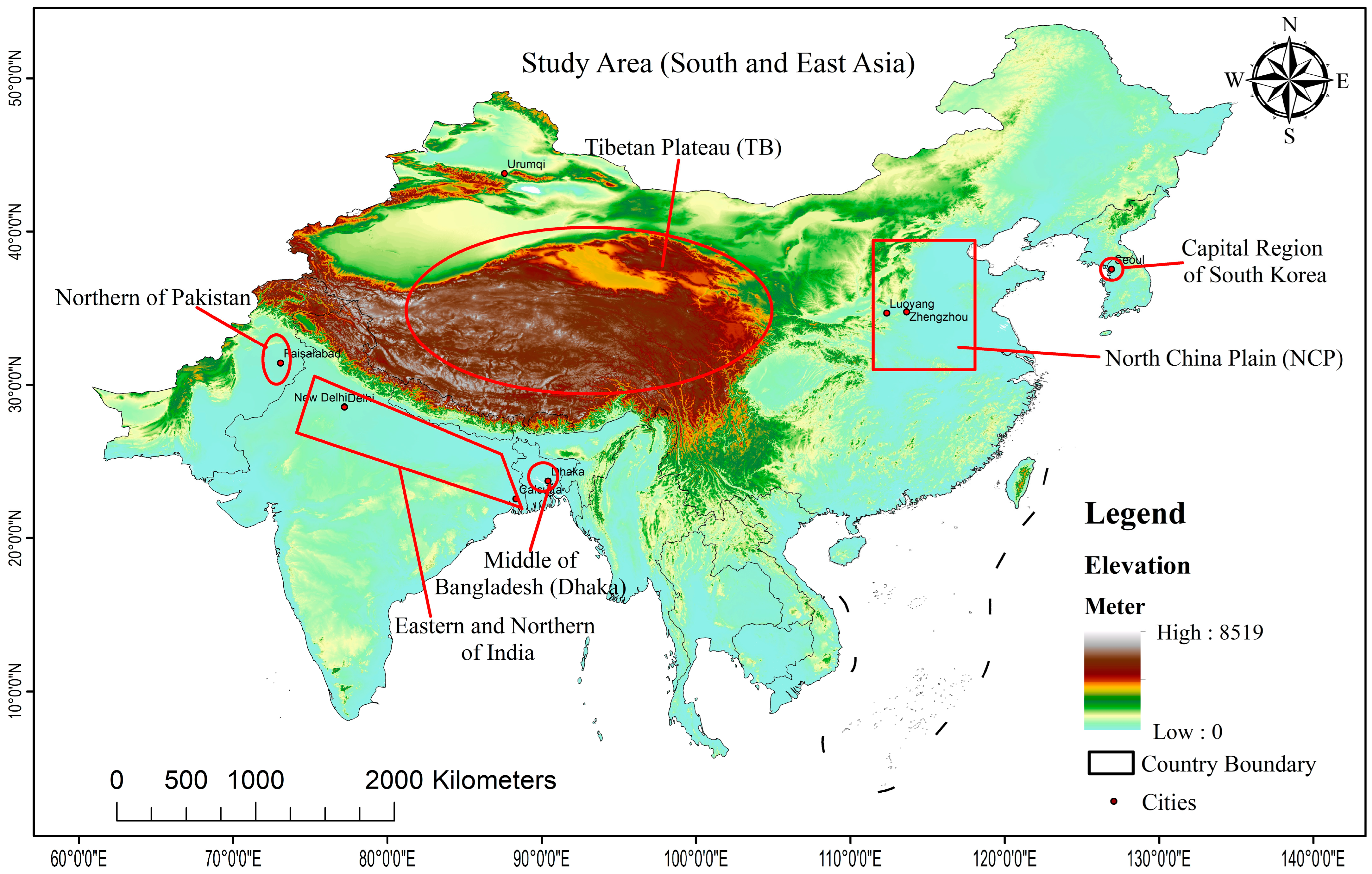





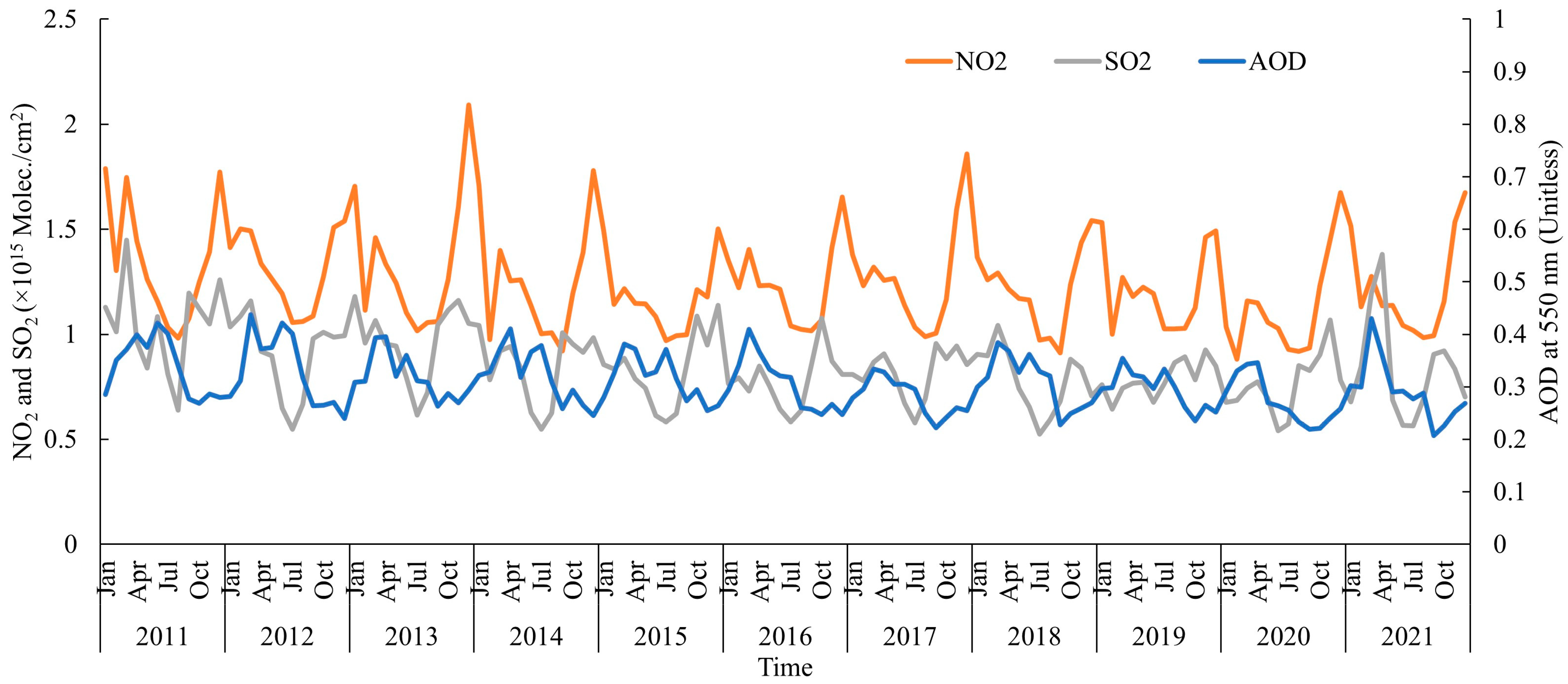
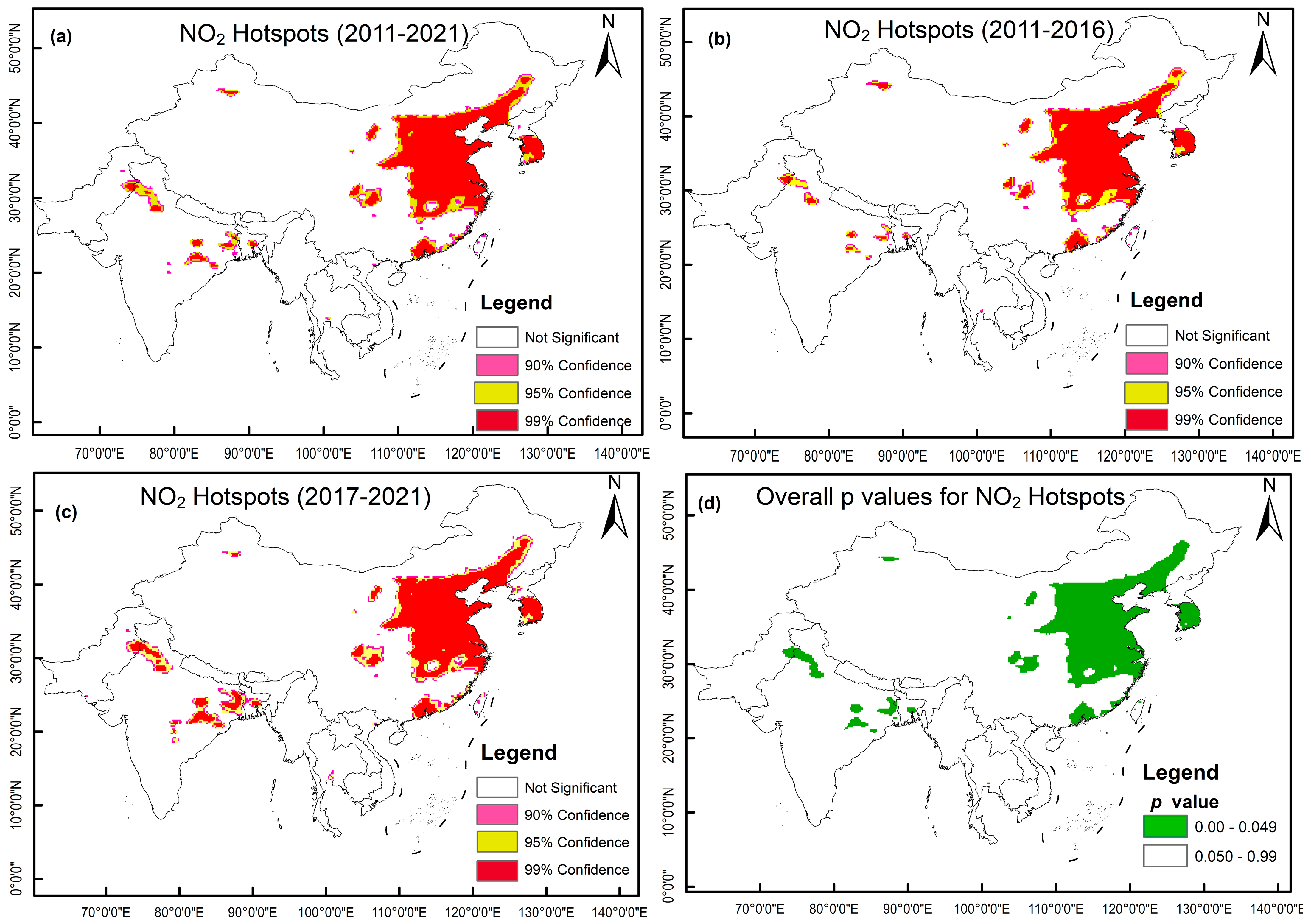
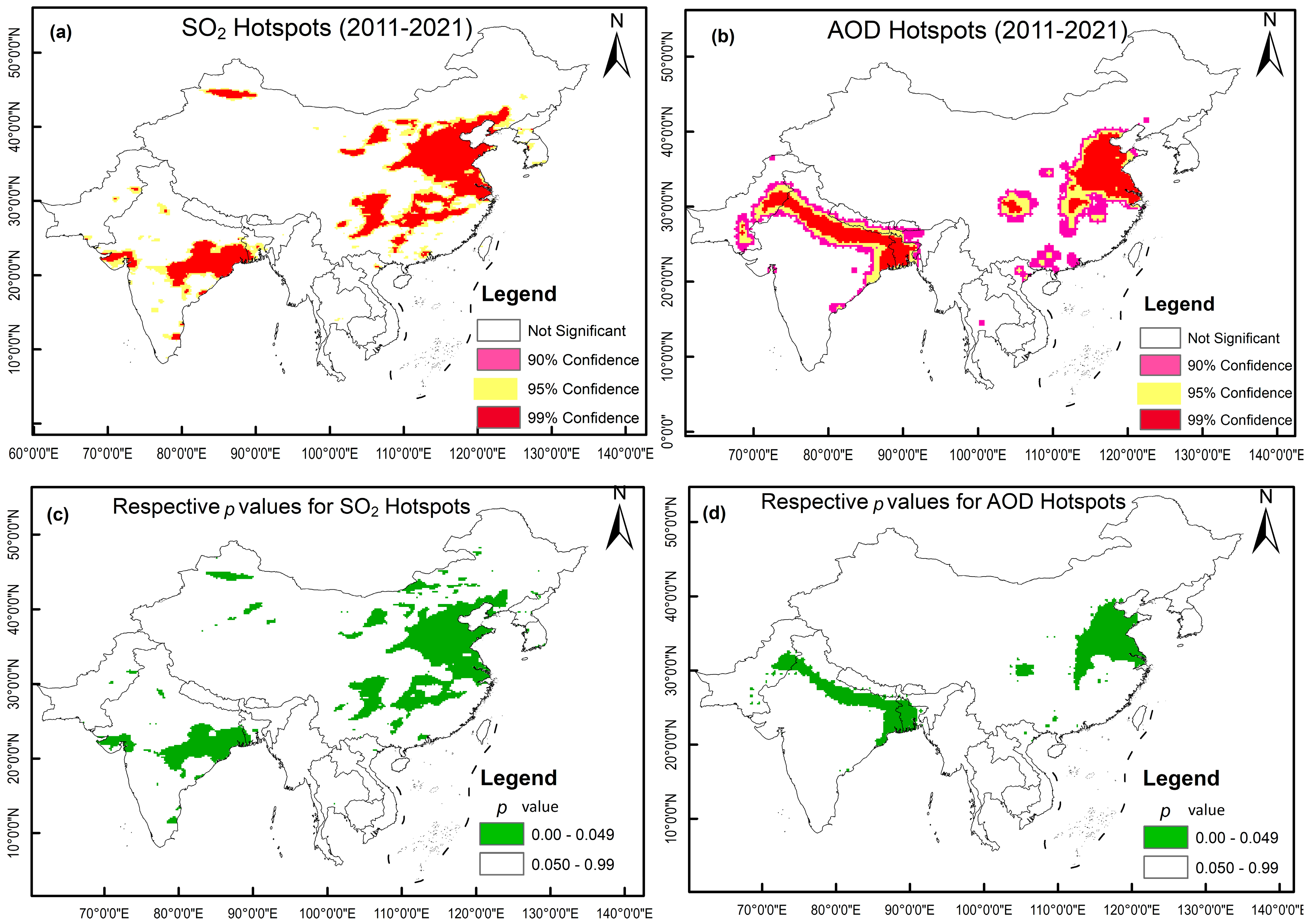
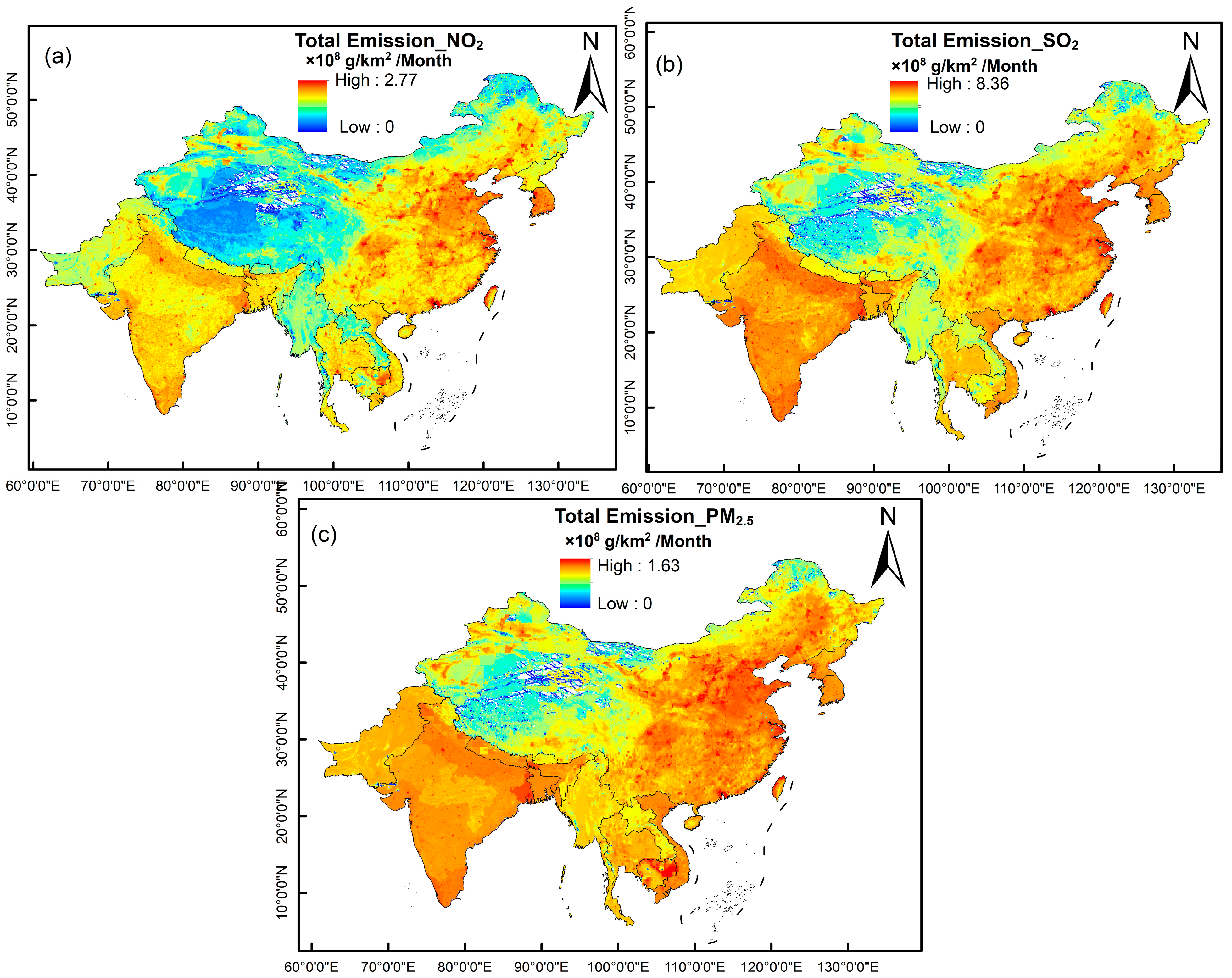
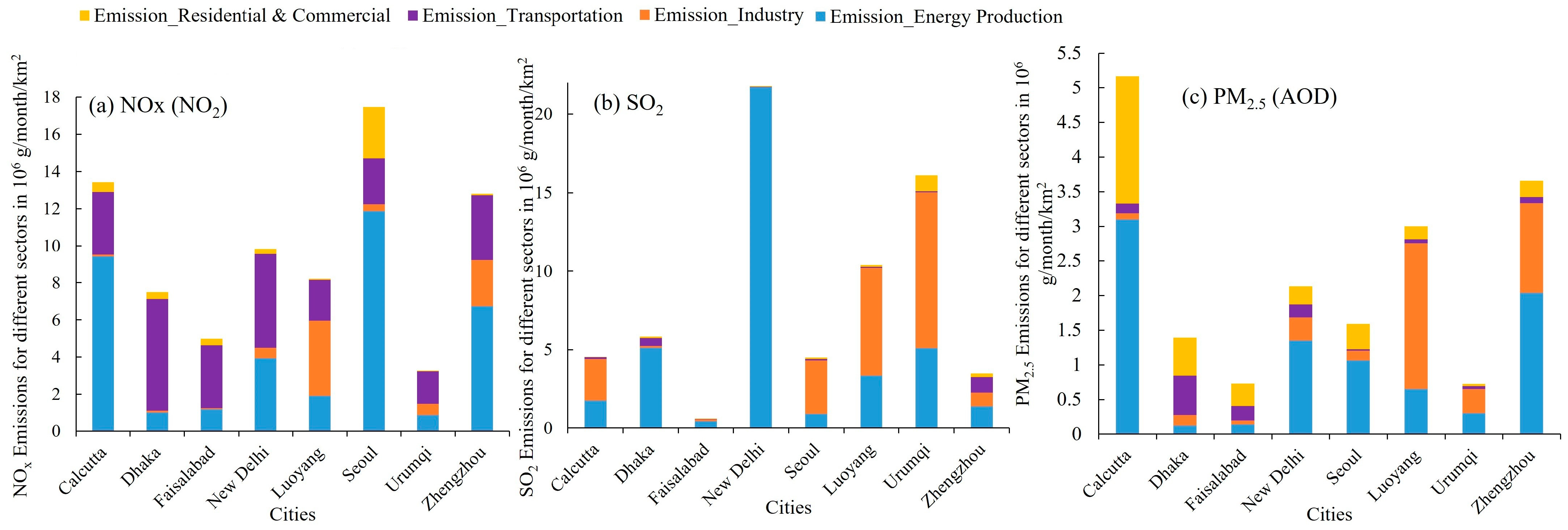
Disclaimer/Publisher’s Note: The statements, opinions and data contained in all publications are solely those of the individual author(s) and contributor(s) and not of MDPI and/or the editor(s). MDPI and/or the editor(s) disclaim responsibility for any injury to people or property resulting from any ideas, methods, instructions or products referred to in the content. |
© 2023 by the authors. Licensee MDPI, Basel, Switzerland. This article is an open access article distributed under the terms and conditions of the Creative Commons Attribution (CC BY) license (https://creativecommons.org/licenses/by/4.0/).
Share and Cite
Rahman, M.M.; Wang, S.; Zhao, W.; Arshad, A.; Zhang, W.; He, C. Comprehensive Evaluation of Spatial Distribution and Temporal Trend of NO2, SO2 and AOD Using Satellite Observations over South and East Asia from 2011 to 2021. Remote Sens. 2023, 15, 5069. https://doi.org/10.3390/rs15205069
Rahman MM, Wang S, Zhao W, Arshad A, Zhang W, He C. Comprehensive Evaluation of Spatial Distribution and Temporal Trend of NO2, SO2 and AOD Using Satellite Observations over South and East Asia from 2011 to 2021. Remote Sensing. 2023; 15(20):5069. https://doi.org/10.3390/rs15205069
Chicago/Turabian StyleRahman, Md Masudur, Shuo Wang, Weixiong Zhao, Arfan Arshad, Weijun Zhang, and Cenlin He. 2023. "Comprehensive Evaluation of Spatial Distribution and Temporal Trend of NO2, SO2 and AOD Using Satellite Observations over South and East Asia from 2011 to 2021" Remote Sensing 15, no. 20: 5069. https://doi.org/10.3390/rs15205069





